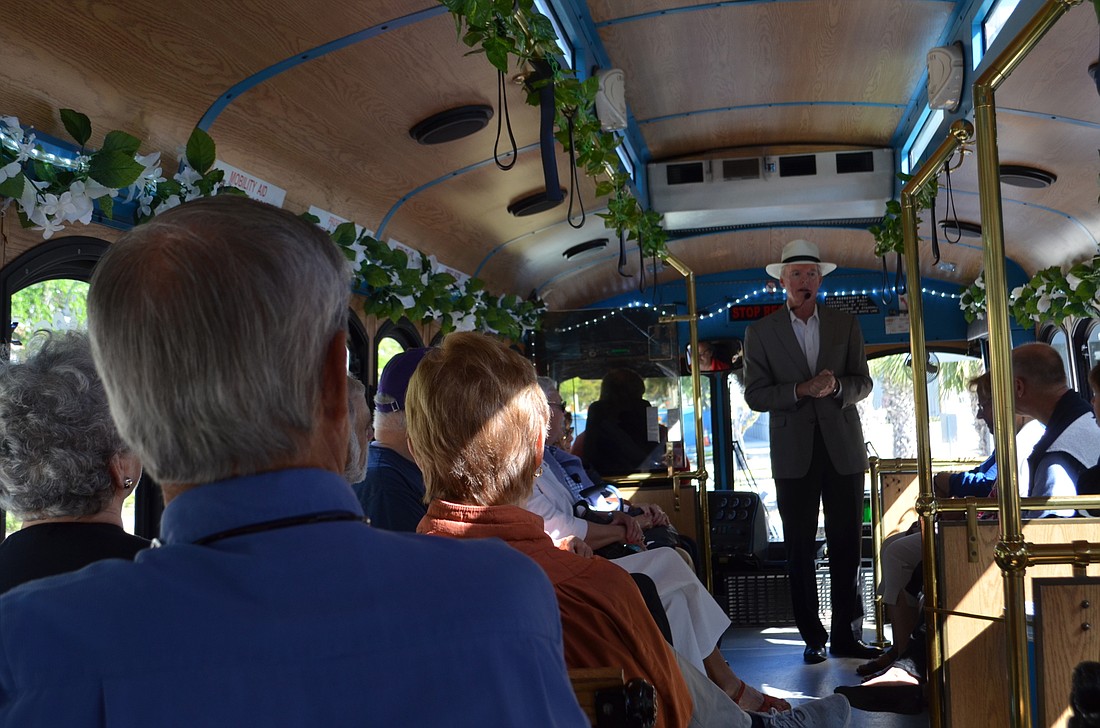- April 2, 2025
-
-
Loading

Loading

From the Mediterranean styles of the 1920s to the Sarasota School of Architecture’s midcentury modern structures, the city’s built environment is rich with history.
But on March 8, as he led a trolley tour highlighting gems of Sarasota architecture, Harold Bubil was first focused on the present.
After setting out from the Center for Architecture, Sarasota’s downtown home, the trolley drove through the Ringling College of Art and Design’s north Sarasota campus. This gave Bubil, the former Sarasota Herald-Tribune real estate editor, an opportunity to showcase two recent additions to the city’s architectural landscape.
The buildings, both completed last year, speak to the possibilities associated with new construction. The Alfred R. Goldstein Library is a distinctly contemporary work that remains in keeping with the iconic modern style that is already woven throughout the city.
The Richard and Barbara Basch Visual Arts Center, by contrast, is a more distinct structure. Bubil said it reflected a progressive strain of modern architecture, using different angles and materials to create a harder-to-define look. Bubil said the structure would not look out of place in some of the most architecturally ambitious cities in the world — something in which he thinks Sarasota residents should take pride.
During the course of the two-hour tour, part of a new series the Center for Architecture launched in February, Bubil highlights some of the standards of Sarasota’s architectural history: the Van Wezel Performing Arts Hall, the Blue Pagoda building, Sarasota High School.
But Bubil makes a point of showcasing new buildings, too. His message is clear: Architecture is an ever-changing field, and the city shouldn’t feel an obligation to be stuck in its past.
“The wonderful thing about Sarasota architecture is that it’s not static,” Bubil said. “This town is not a museum of architecture. It’s an evolving palette for architecture.”
The Center for Architecture hopes residents are eager to learn more about the spectrum of noteworthy architecture throughout Sarasota. The organization sees the trolley tours as an opportunity to engage with the public — and to help create a community that is more thoughtful about the buildings it uses.
Tammy Hauser, executive director of the Center for Architecture, sees the tours as a natural extension of the organization’s mission. Founded in 2013, the center positions itself as an advocate for quality architecture, a hub for educational opportunities and a facilitator of community conversations.
So far, the trolley tours have been a hit. The center offers weekly tours on Thursday mornings, alternating between Bubil’s “Sarasota’s Architectural Gems (Northside)” and Lorrie Muldowney’s guide to historic neighborhoods in the city center. The tours, which seat 30 people each, have sold out each time.
“I think this community draws very smart, curious people from all over the world,” Hauser said. “They appreciate the beauty of this town, which has the beautiful natural landscape and really interesting architecture combined with that.”
Muldowney formerly served as the county’s historical resources specialist and manager of the Sarasota County History Center. For her, the tours are an opportunity to share the history built into neighborhoods that even long-time residents might not necessarily note.
By sharing the working-class roots of neighborhoods such as Laurel Park and the Rosemary District, Muldowney also hopes to emphasize the long-term viability of older homes and the benefits of historic preservation.
“What’s important to me is to share with people that there can be very gracious living in these smaller homes that are west of the trail, and there’s a nice lifestyle there,” Muldowney said “There’s great walkability. There’s mature trees. It’s appealing.”
The blend of past and future exhibited in the tours speaks to the goals of the Center for Architecture — preserve quality buildings whenever feasible, and build exemplary works whenever new structures must be erected.
“Our hope is that more people will have that understanding and won’t destroy or take for granted special buildings,” Hauser said.
Based on the early success, Hauser is already working to offer additional tours. The Center for Architecture is also in discussions with organizations throughout the state and country, exploring options for possible destination tours to show off different architectural styles not present in Sarasota.
Hauser is hopeful the tours can be part of a larger effort to make Sarasota residents more considerate about the effects of good architecture. She said good buildings can provide the foundation for a happier, healthier and higher-quality community.
“When you really boil it down, this is about making the world a better place, I think,” Hauser said.